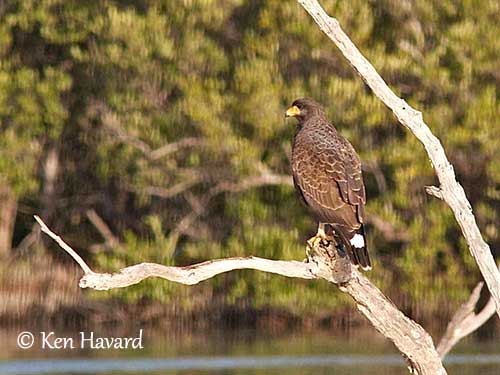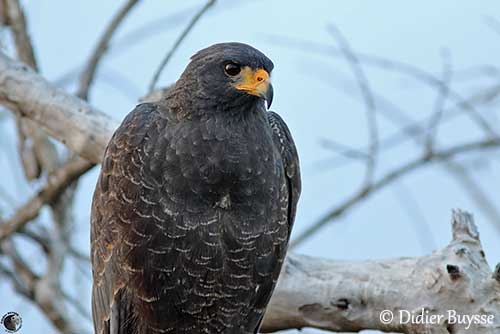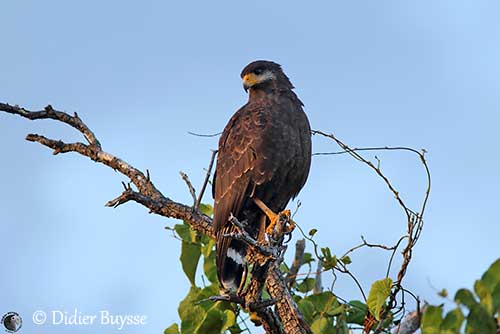Fr: Buse de Gundlach
Ang: Cuban Black Hawk
All: Kubabussard
Esp: Busardo cubano
Ita: Poiana nera di Cuba
Nd: Cubaanse Zwarte Buizerd
Sd: kubasvartvråk
Photographers:
Didier Buysse
Vision d’Oiseaux
Ken Havard
My Bird Gallery & Flickr gallery 1 & Flickr gallery 2
William Price
PBase-tereksandpiper & Flickr William Price
Text by Nicole Bouglouan
Sources:
HANDBOOK OF THE BIRDS OF THE WORLD Vol 2 by Josep del Hoyo-Andrew Elliot-Jordi Sargatal - Lynx Edicions - ISBN: 8487334156
BIRDS OF THE WEST INDIES – by Herbert Raffaele, Kristin Williams et Tracy Pedersen – Helm – ISBN: 9780713649055
Global Raptor Information Network - Working to Conserve Birds of Prey in nature
Neotropical Birds – Cornell Lab of Ornithology
Wikipedia, the free encyclopaedia
Arthur Grosset's Birds (Arthur Grosset)
THE JOURNAL OF RAPTOR RESEARCH
TAXONOMIC STATUS AND BIOLOGY OF THE CUBAN BLACK HAWK
By JAMES W. WILEY and ORLANDO H. GARRIDO
Cuban Black Hawk
Buteogallus gundlachii
Accipitriformes Order – Accipitridae Family
INTRODUCTION :
The Cuban Black Hawk was formerly a subspecies of the Common Black Hawk (B. anthracinus), but it differs by browner plumage and tail pattern. It also lacks the mottled rufous wing panel, but it has a white underwing patch on primaries.
The Cuban Black Hawk is endemic to Cuba and adjacent outlying cays. It frequents coastal swamps and mangroves where it can find crabs, its preferred food.
This species is threatened by habitat loss, and has small population restricted to few locations.
RANGE:
The Cuban Black Hawk is resident on Cuba and Isle of Pines.
HABITAT:
The Cuban Black Hawk frequents coastal swamps and mangroves, forest borders and wooded coasts. It can be seen in mountains too, mostly below 800 metres of elevation.
On Isle of Pines, it has been reported in sparsely vegetated mangrove areas and flooded openings, and foraging and roosting in beach and coastal habitat, perched in trees.
CALLS AND SONGS: SOUNDS BY XENO-CANTO
The Cuban Black Hawk gives loud, harsh cackling “kek-kek-kek-kek-kek-kek”. The alarm call is a repeated series of three short whistles with stronger two first notes. It also gives a wailing squeal.
BEHAVIOUR IN THE WILD:
The Cuban Black Hawk feeds primarily on crabs found in mangroves and coastal swamps. But it also takes carrion (fish), rodents and lizards, and occasionally medium-sized birds.
It hunts from perch or from the ground where it walks while searching for preys. The prey is caught with the talons.
The courtship displays of the Cuban Black Hawk are not described, but we can suggest that they are similar to those of the Common Black Hawk and include aerial displays at the beginning of the breeding season. The bird rises with exaggerated wingbeats, circles and glides with dangling legs while calling loudly. The copulation occurs in the vicinity of the nest. They are monogamous with long-term pair-bonds.
The Cuban Black Hawk is largely sedentary within its range.
In flight, the white underwing patches are conspicuous. It performs rapid wingbeats followed by short glides.
REPRODUCTION OF THIS SPECIES:
The breeding season takes place between March and June, but it may start sometimes as early as January.
The stick nest is usually built beneath the canopy of the mangroves. It is made with branches and twigs found in the mangroves. The cup-shaped structure is lined with mangrove green leaves and sprigs. It is placed between 3,5 and 8 metres above the ground, in tree fork in tall tree.
The female lays 1-2 greyish-white eggs with reddish-brown markings. The duration of the incubation is unknown, but it lasts 39-40 days in Common Black Hawk, and the chicks fledge 43-50 days after hatching. We can suggest that this information is probably valid for the present species too.
PROTECTION / THREATS / STATUS:
The Cuban Black Hawk has restricted range in which it is relatively rare although widely distributed.
The species is threatened by habitat loss, through drainage and degradation of suitable areas, and this habitat is now more fragmented.
The global population is estimated to number 10,000 mature individuals, equivalent to 15,000 individuals. However, national estimates are lower, with less than 2,500 mature individuals, and this population is declining.
The Cuban Black Hawk is currently classified as Near Threatened.


DESCRIPTION OF THE BIRD:
Biometrics:
Length: 43-52 cm
Weight of the male: 650 g
The Cuban Black Hawk is smaller overall than the Common Black Hawk. This raptor is a chunky forest hawk, with fairly short, rounded wings and narrow tail with rounded tip.
The adult has blackish-brown upperparts with darker crown and back. The underparts are slightly paler and greyer, with weak grey-brown barring. We can see a large whitish patch at base of primaries on the underwing. The other flight feathers are barred pale grey/dark grey, while tips are blackish. Underwing-coverts are blackish-brown. The blackish tail shows a broad, white band at mid-length, and a narrow, white terminal band.
On the head, we can see an indistinct white malar stripe.
Cere, lores, legs and feet are deep yellow to yellow-orange. The tip of the bill is black and hooked. The eyes are dark brown.
Male and female have similar plumage, but the female is slightly larger than male.
The juvenile is brown above, while the whitish underparts are heavily streaked dark brown. The eyes are paler than in adults.
